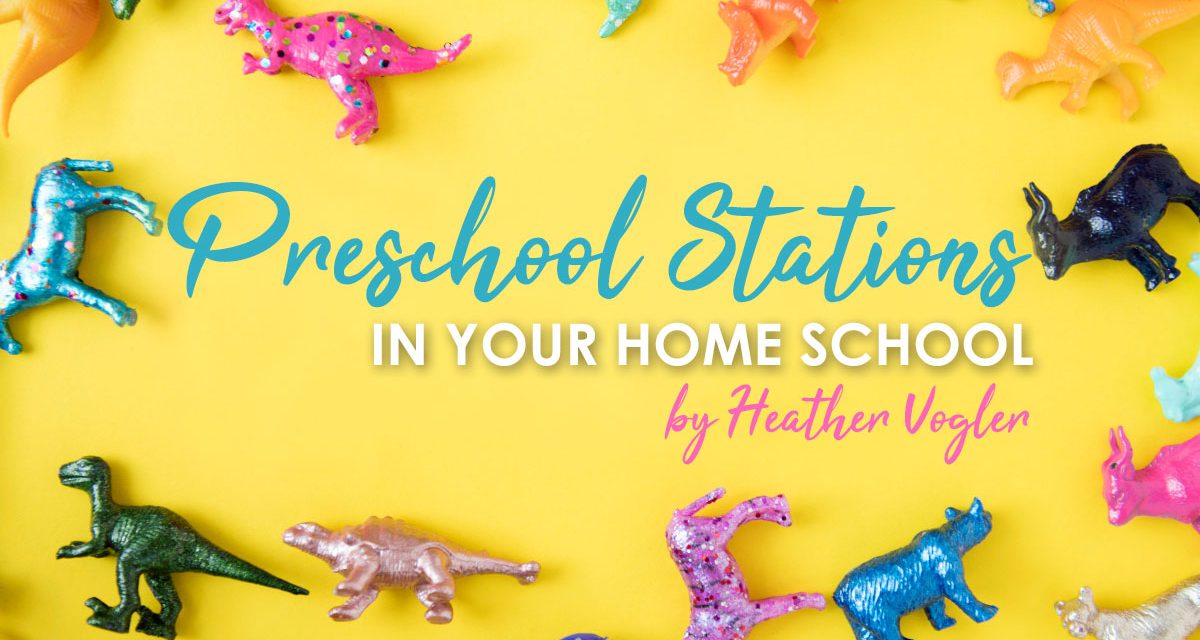Homeschooling a toddler is challenging but after a several kids I have finally come up with a doable solution. I had a toddler only a year ago and now my baby is no longer sleeping most of the day and which means he now needs the same structure his older brother had. My solution for that age is; playpen time. Placing my toddler in a playpen while we do school works in about 30 -45 minute spurts and is a tremendous blessing. So what do I do now that my three-year-old has outgrown this stage? After experiencing much chaos in letting him simply, “play by himself” while we do school I decided to introduce my son to “stations.” Before kids, when I taught preschool, “stations” were a perfect way to keep structure in the classroom. The room was set up with a music station, reading station, science station, art station and so forth. The kids would split up into groups and travel from station to station for a set amount of time. Even though I am not usually a fan of attempting to recreate the classroom setting in our homeschool, in this case I am perfectly fine with it, because it works.
For my son, I keep it simple since he is only three. Which means activities that include cutting and glueing are out. For him, I have a Lego station, color station, counting station, toy station and letter station. Rather than setting a timer for the stations, I tell him he has to stay in one station until I am done with a particular subject with the older ones. I have three subjects that I do with my older kids as a group each day, then they go off and do their own individual work. While we work on the group work, my son does his stations. I pick three each day and he knows he has to wait for me to tell him when to switch. Since he was used to playing in the playpen when he was younger as we did school, this isn’t too entirely strange to him and he has fallen nicely into the routine.
Some ways to make this time enjoyable for everyone in the family is to be sure to set some ground rules with our preschooler from the get-go. Make sure they understand that you are teaching at this time and cannot be interrupted unless it is extremely important. (Needing help connecting two Lego pieces does not count.) If he does need to speak to you have him place his hand on you and wait patiently for you to acknowledge him. There is nothing more frustrating for you and their older siblings than being interrupted mid-sentence when trying to teach a new concept in science.
When trying to decide which activities will work for your child think about what holds his interest the most. If your child likes Paw Patrol, print out Paw Patrol related activities, laminate them and create a reusable game he can use over and over again. One activity my son loves is having a magnetic board with different letters he can place on it. Even though he is not to the point of putting words together on his own, he knows some of his letters and enjoys playing around with them. For the color station, I have several colored clothespins. It is a simple concept but he loves organizing them by color and making trains out of them. It keeps him entertained because he can only play with it during a designated time so he enjoys it during that time. Activities that do not work are ones that are active or loud since it distracts the older kids and gets the baby worked up making him wanting to climb out of his pack and play and join in on the fun. Another one that has not worked for him is a video station. It worked for my other kids though. If they were learning about the letter D that week then I would set up a few videos that showcased the letter D. This does not work for my current preschooler. He just isn’t ready for that kind of freedom. He isn’t responsible with it and gets too wound up after he watches it. Calm yet interactive activities are what work for him.
If you want to go one step further, you can print out pictures of each activity, laminate them and put velcro on the back of each one. Have a place on the wall or in a binder where your child can place the activity on when they have completed it. This worked best with my middle son when he was a preschooler. It helped him understand what needed to be done and then feel a sense of accomplishment when they were completed.
My current preschooler enjoys these activities and even though it took a few days to figure out what worked best for him we are now in a good routine that helps the day go smoother for all of us.





